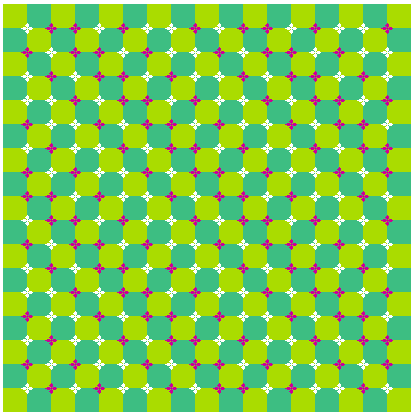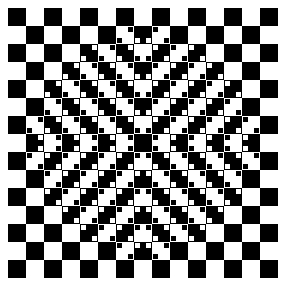The majority of the information I found was in the realm of neuropsychology, discussing the underlying mechanisms of the visual system that lead to the creation of illusion. While a cursory understanding of this area will be essential to a thorough project, the search results were much too detailed for my purposes.
From Google, I found two very interesting sites:
Michael Bach provided some excellent explanations on how optical illusions work.
Akiyoshi Kitaoka has provided the main basis for my work. His illusions :
 and
and
will be the main components of my final project.
Most of the other papers are specific descriptions of CG techniques such as Phong Shading, or ruminations on possible uses for illusion. One paper in particular is very interesting, however, Phenomenal Characteristics of Peripheral Drift Illusion"[A. Kitaoka, 2003], which is the best explaination on HOW to generate a specific illusion I have ever seen. I will have to request Dr. Kitaoka's other papers.
my current bibliography (if you missed it in the litsum)
- [Gouraud 1971] H. Gouraud, "Computer Display of Curved Surfaces," Department of Computer Science, University of Utah, (June 1971).
- [Phong 1975] B.T. Phong, "Illumination for Computer Generated Pictures," Communications of the ACM 18, 6, 311- 317, (June 1975).
- [Blinn 1978] J. F. Blinn, "Simulation of wrinkled surfaces," in SIGGRAPH 78, pp. 286-292, (1978).
- [Freeman, Adelson, Heeger 1991] W.T. Freeman, E.H. Adelson, D.J. Heeger, "Motion Without Movement," Computer Graphics, Volume 25, Number 4, (July 1991).
- [Kitaoka, Ashida 2003] A. Kitaoka, H. Ashida, "Phenomenal Characteristics of the Peripheral Drift Illusion," VISION Vol. 15, No. 4, pp. 261-262 (2003).
- [Fermeuller, Pless, Aloimonos 1996] C. Fermeuller, R. Pless, Y. Aloimonos, "Families of Stationary Patterns Producing Illusory Movement: Insights into the Visual System," Computer Vision Laboratory, University of Maryland, College Park, MD, (October 1996).
- [Kitaoka 2002] A. Kitaoka, "Primrose's Field," Trick Eyes, (2002).
- [Yu, Choe 2004] Y. Yu, Y. Choe, "Angular Disinhibition Effect in a Modified Poggendorff Illusion," Department of Computer Science, Texas A&M University, (2004).
- [Christie 1975] P.S. Christie, "Asymmetry in the Mueller-Lyer illusion: Artifact or genuine effect?" Perception 4:453-457 (1975)
- [Eidos 1995] Eidos Interactive, "Thief: the Dark Project," Eidos Interactive, (1995).
If anyone has any links to papers on visual illusion specifically in the context of CG, please let me know. Remember, a visual illusion could be practically anything. Any time CG aims to represent reallity through less-than-reallistic modelling, that is essentially an illusion. So, papers that deal in maximizing poly counts are probably about making modelling more reallistic, and therefore are not in my problem domain. Papers that deal with shading/texturing/whatever to make up for lack of detail in modelling ARE in my problem domain.